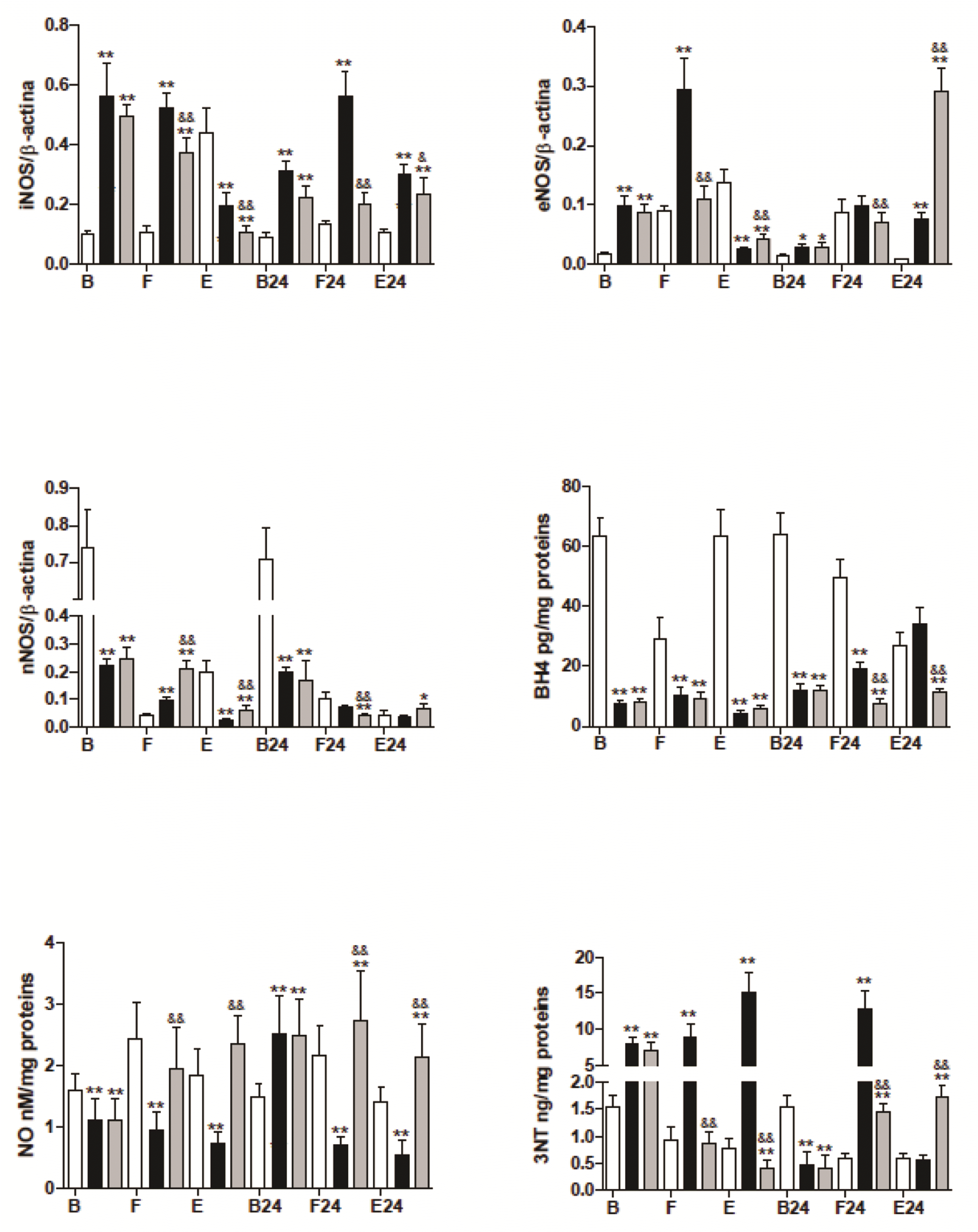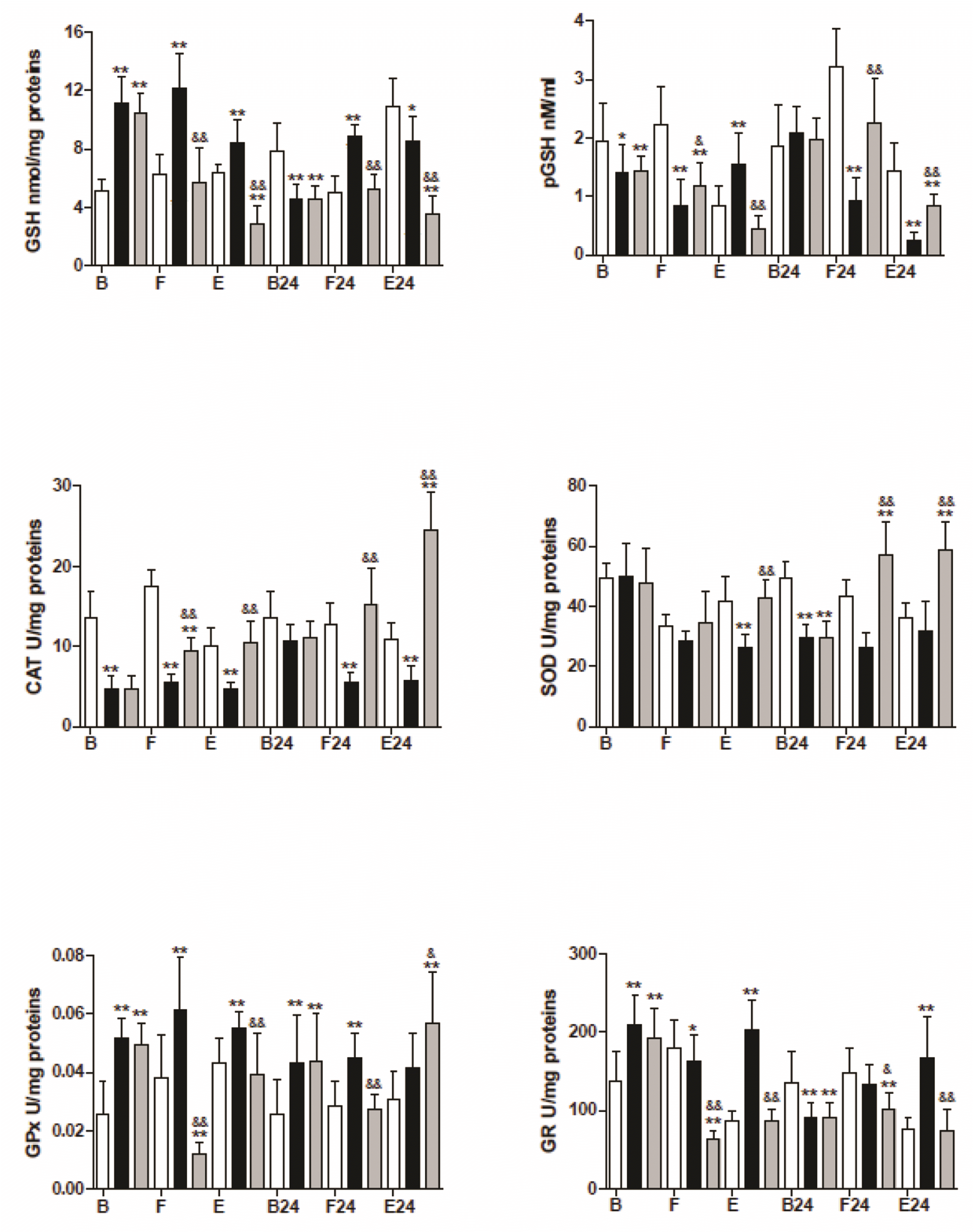INTRODUCTION
METHODS
Animal model
Study design
Table 1
A hyperbaric oxygenation (HBO) session was administered before the stress event (HBOP group) or afterwards (HBOA group). The three groups (control, HBOP, and HBOA) were each divided into three subgroups: basal (B), fasting (F), and prolonged exercise (E). Measurements each group were made before and immediately after the stress event (B, F, and E) and following a 24-h recovery period (B24, F24, and E24). Tissue samples were taken where the box is marked with an “x”.
Sample processing
Western blot
RESULTS
Effects of HBOP
 | Fig. 1Basal and post-stressed parameters related to the NO production were measured in muscle tissue of mice immediately and after 24 h of the recovery period.The three groups were the control (white columns), hyperbaric oxygen preconditioning (HBOP, black columns), and hyperbaric oxygen session after the stress event (HBOA, grey columns). Subgroups: B, basal; F, fasting (mild stress); E, prolonged exercise (hard stress). B24, F24, and E24: corresponding recovery subgroups. Values are expressed as the mean ± SD. NO, nitric oxide; NOS, nitric oxide synthase; iNOS, inducible NOS; eNOS, endothelial NOS; nNOS, neuronal NOS; BH4, tetrahydrobiopterin; 3NT, 3-nitrotyrosine. *p < 0.05 and **p < 0.01 compared to the corresponding control inside each subgroup. &p < 0.05 and &&p < 0.01 compared to the other experimental group inside each subgroup.
|
 | Fig. 2Basal and post-stressed parameters related to the antioxidant response were measured in muscle tissue of mice immediately and after 24 h of a recovery period.The three groups were the control (white columns), hyperbaric oxygen preconditioning (HBOP, black columns), and hyperbaric oxygen session after the stress event (HBOA, grey columns). Subgroups: B, basal; F, fasting (mild stress); E, prolonged exercise (hard stress). B24, F24, and E24: corresponding recovery subgroups. Values are expressed as the mean ± SD. GSH, glutathione; pGSH, plasma GSH; CAT, catalase; SOD, superoxide dismutase; GPx, glutathione peroxidase; GR, glutathione reductase. *p < 0.05 and **p < 0.01 compared to the corresponding control inside each subgroup. &p < 0.05 and &&p < 0.01 compared to the other experimental group inside each subgroup.
|
Effects of HBOA
Correlation analysis
Table 2
| iNOS | nNOS | eNOS | BH4 | NO | 3NT | GSH | CAT | SOD | GPx | GR | pGSH | EST | Parameters |
|---|---|---|---|---|---|---|---|---|---|---|---|---|---|
| –0.52* | 0.55* | 0.75** | –0.66** | 0.56* | –0.51* | iNOS | |||||||
| 0.57* | nNOS | ||||||||||||
| 0.67** | eNOS | ||||||||||||
| –0.51* | BH4 | ||||||||||||
| –0.67** | –0.74** | 0.75** | –0.60** | 0.58* | NO | ||||||||
| 0.72** | –0.66** | 0.54* | 0.66** | 3NT | |||||||||
| –0.74** | 0.50* | 0.77** | GSH | ||||||||||
| 0.57* | –0.51* | CAT | |||||||||||
| SOD | |||||||||||||
| –51* | GPx | ||||||||||||
| –0.50* | GR | ||||||||||||
| pGSH | |||||||||||||
| EST | |||||||||||||
NO, nitric oxide; NOS, nitric oxide synthase; iNOS, inducible NOS; eNOS, endothelial NOS; nNOS, neuronal NOS; BH4, tetrahydrobiopterin; 3NT, 3-nitrotyrosine; GSH, glutathione; pGSH, plasma GSH; CAT, catalase; SOD, superoxide dismutase; GPx, glutathione peroxidase; GR, glutathione reductase; EST, plasma estradiol. *p < 0.05 and **p < 0.01.
Table 3
| Control | r | HBOP | r | HBOA | r |
|---|---|---|---|---|---|
| iNOS-GPx | 0.841* | GSH-nNOS | 0.802* | eNOS-iNOS | 0.901** |
| eNOS-SOD | 0.849* | GSH-GPx | 0.790* | eNOS-NO | –0.788* |
| eNOS-3NT | 0.951** | GSH-CAT | –0.807* | nNOS-CAT | 0.852* |
| eNOS-BH4 | 0.798* | pGSH-BH4 | –0.798* | nNOS-3NT | 0.792* |
| nNOS-NO | 0.865* | pGSH-NO | 0.820* | 3NT-SOD | 0.802* |
| nNOS-GPx | 0.804* | eNOS-SOD | 0.874* | 3NT-CAT | 0.800* |
| SOD-BH4 | 0.947* | NO-CAT | 0.912** | ||
| CAT-GR | 0.934** |
HBO, hyperbaric oxygenation; HBOP, HBO preconditioning; r, correlation coefficient; NO, nitric oxide; NOS, nitric oxide synthase; iNOS, inducible NOS; eNOS, endothelial NOS; nNOS, neuronal NOS; BH4, tetrahydrobiopterin; 3NT, 3-nitrotyrosine; GSH, glutathione; pGSH, plasma GSH; CAT, catalase; SOD, superoxide dismutase; GPx, glutathione peroxidase; GR, glutathione reductase. *p < 0.05; **p < 0.01.
Response to mild and hard stress
Table 4
Significant changes are indicated as an increase (I), decrease (D), or no change (unmarked). Each post-fasting level is compared to the corresponding basal level, and each post-exercise level to the corresponding post-fasting level (net response). NO, nitric oxide; NOS, nitric oxide synthase; iNOS, inducible NOS; eNOS, endothelial NOS; nNOS, neuronal NOS; BH4, tetrahydrobiopterin; 3NT, 3-nitrotyrosine; GSH, glutathione; pGSH, plasma GSH; CAT, catalase; SOD, superoxide dismutase; GPx, glutathione peroxidase; GR, glutathione reductase; EST, plasma estradiol; C, control; HP, the HBOP group; HA, the HBOA group.




 PDF
PDF Citation
Citation Print
Print


 XML Download
XML Download